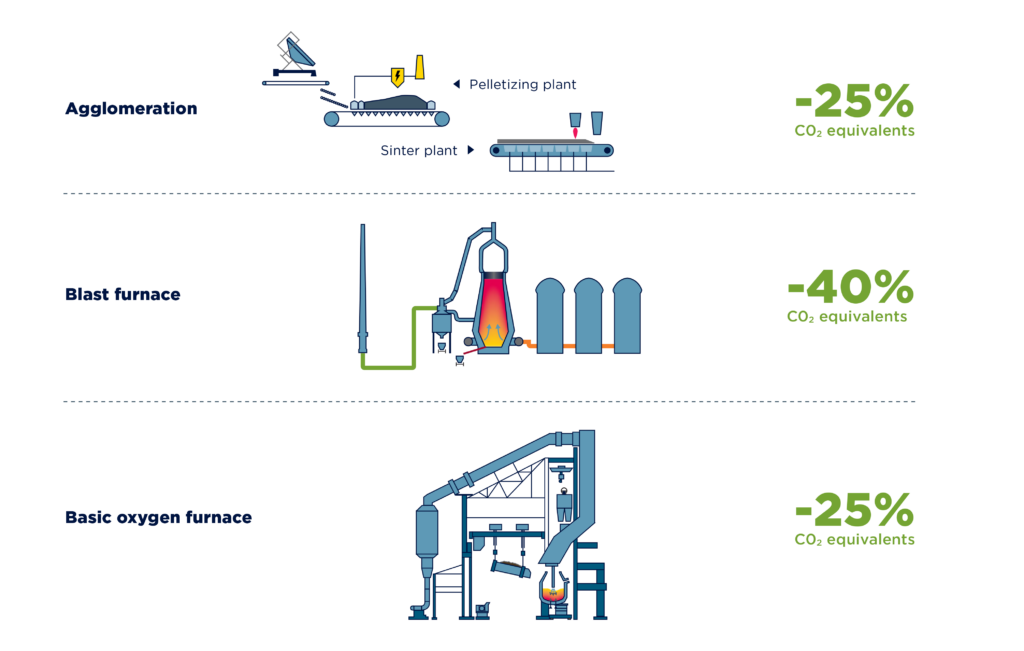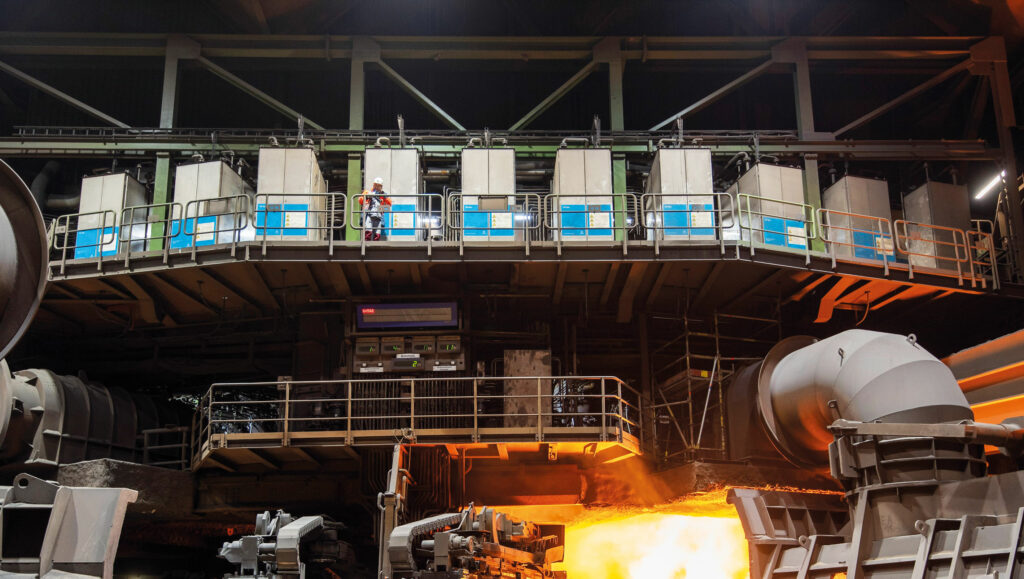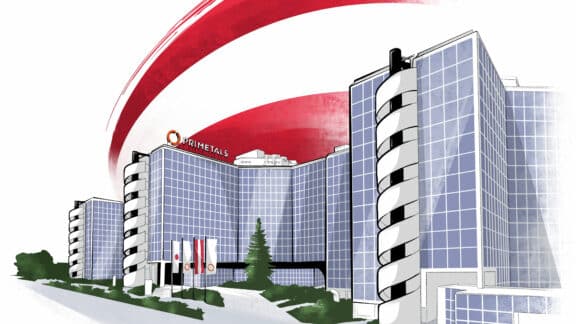Today, the technological landscape of the metals industry, filled with readily available technologies, offers ideal opportunities for producers to begin their transformation toward a sustainable production process, from improving scrap rates to energy efficiency. What’s more, when implemented with the future in mind, these solutions will lay the foundation for decades of advancement.
Developed over 70 years ago, the LD process (basic oxygen furnace) revolutionized the steel industry. Today, the blast furnace (BF) and basic oxygen furnace (BOF) route comprise approximately 70 percent of worldwide steel production. However, around 1,770 kilograms of CO2 per ton of steel is emitted from coke plants, sinter plants, and blast furnaces during pig iron production. In the BOF, an additional 170 kilograms is added as the iron is refined into steel. These figures present the most significant challenge for many producers on the path toward decarbonization. For pioneers, these figures are an opportunity.
Immediate Potential
As increased pressures to improve the environmental impact of the steel industry emerge throughout the world, the immediate opportunities available to producers can see their CO2 emissions reduced by approximately 30 percent by investing in technologies to improve material and energy efficiency. The potential of these improvements also translates to increased yield and performance and reduced maintenance costs. Zeroing in on the two most predominant assets in the BF-BOF route, optimal improvements to the blast furnace and basic oxygen furnace can help reduce emissions by improving performance and efficiency.
Reduction Opportunities in the Optimization Phase

most of which can be achieved with reasonable alterations to the production process.
The Sequence Impulse Process (SIP) developed with thyssenkrupp AT.PRO provides immediate improvements to blast furnace performance, shifting the coal-coke ratio to more coal. SIP functions, in summary, by producing pulsations of oxygen into the blast furnace in addition to the existing air flow. The opening and closing of the valve rapidly allow for deeper penetration into the raceway and improve the conversion behavior of the coal and coke. The results mean that cheaper injection coal can be utilized in the blast furnace, and thanks to improved throughput and drainage, production can also increase.

SIP has already demonstrated improvements in performance and a reduction in emissions.
Remaining with the blast furnace, the energy consumption of the blast furnace, in addition to its carbon emissions, also makes up about 75 percent of the total energy consumption of a steel plant. Top-gas Recovery Turbines (TRT) take the off-gas pressure and turn it into mechanical and electrical energy. Furthermore, for blast furnaces undergoing a relining process, copper staves from Primetals Technologies also offer increased fuel efficiency by five percent and a slight reduction in carbon emissions.
Increased Scrap Use
The increased scrap use in steel production is a clear focal point throughout all phases progressing toward green steel, from applications in the BOF to electric steelmaking. As a nearly infinitely recyclable material, steel is inherently sustainable. However, from scrap sorting to increasing scrap rates in existing integrated plants lies an immense opportunity for decreased emissions and improved efficiency.
Integrated steelworks operating a basic oxygen furnace confronted with the challenge of reducing carbon emissions may often turn to increased scrap use, but this is not without its challenges. Firstly, scrap logistics from the scrap yard presents a primary problem for producers that will continue even as producers transition to electric steelmaking. While the transportation of scrap to the meltshop is an essential consideration for interplant logistics, scrap sorting and separation are vital. By partnering with SICON, Primetals Technologies has developed “crafted scrap.” A term associated with both innovative automation and digital solutions as well as an improved standard for scrap, crafted scrap refines scrap coming from the scrap yard, improving on the status quo, which has producers operating on a “worst-case-scenario” basis. In the future, scrap supplies will contain low amounts of contaminants that ensure the production of high-quality scrap-based steel as more producers adopt scrap sorting solutions into their plants.
Emissions Reduction in the BOF
Beyond scrap sorting solutions, the BOF also has immense potential regarding an increase in scrap use. However, current BOF operation limits the amount of scrap processing from 15 to 20 percent. Thankfully, available solutions can increase the scrap rate. Firstly, as with many optimization solutions, the application of process models and digital solutions can reveal the ideal melting conditions of the converter to operators, reducing the use of cooling agents to reach the ideal tapping temperature late in the production process. Process models for the BOF from Primetals Technologies decrease the number of reblows, stabilizing production, which preserves the energy required for scrap melting and helps reach target temperatures.
Scrap preheating can also provide immediate benefits and reduce the energy required to melt scrap in the BOF. Heating scrap to an average of 800 degrees Celsius using a burner lance and natural gas can increase the scrap rate by approximately five percent. Implementing a dual-flow post-combustion lance can also increase the rate of CO combusted to CO2 from 12 to 20 percent, where a second control line allows for additional oxygen injection for post-combustion.
Finally, the Jet Process utilizes a bottom-blowing converter with lime, coal injection, and hot-blast lance for the highest-possible post-combustion in a BOF. This process ensures the maximum use of chemical energy from the coal with an efficiency greater than that of an electric arc furnace using electricity from a coal-based power plant. By implementing the previously mentioned solutions, the scrap rate can increase to as much as 30 percent. However, thanks to the bottom-blowing converter technology of the Jet Process, the scrap rate in the BOF can reach 50 percent, and thanks to the efficient use of coal, carbon emissions are nearly 40 percent lower.
Digitalization is essential for material and energy efficiency, from measurement technology to data management. Today, producers no longer look at individual assets but optimize the entire production process from raw material input to finished steel. These technologies are crucial to a sustainable metals industry.

Creating Harmony
When implementing solutions for optimizing production routes, the number of digital and automation solutions can often appear as daunting as the data they will process. Terms like “data lakes,” “machine learning,” and “data processing and analysis” are becoming commonplace in an industry traditionally focused on the quintessentially tangible. The network of the actual steel plant, recorded by sensors and process models, lies beneath the surface of digital tools and solutions. Producers benefit from seeing their entire production route transform into a digital orchestra, where each asset and component of the process interact in perfect harmony.

Eliminating Downtimes
Unscheduled downtime can be detrimental for a metals producer. Thanks to digital twins, automation tools, and software, unplanned downtime can become a thing of the past. When implementing new solutions, changes to logistics, assets, and operations can be tested for a plant’s offline digital twin, and simulations can inform real-world operation. Moreover, with the installation of a digital and automation infrastructure, digital assistants provide continuous updates analyzing the conditions of assets, allowing for predictive maintenance. Digitization also facilitates plant maintenance, including condition monitoring and spare part orders.

Anticipating Changes
On the journey toward green steel, through-process digital solutions play an essential role in laying the foundation for a sustainable metals industry. What’s essential is that the transformation of production toward a digital and automated process translates into a seamless integration of new technologies and emergent green steel technologies down the line. These solutions optimize current production and accelerate transformation. Producers forging a path toward green steel by transitioning their production to one reinforced by digital tools, are securing success for decades.
Optimizing for a Transition
The technologies listed are just the beginning of an immense portfolio of readily available technologies designed to optimize production routes and energy efficiency. With these solutions in mind, producers can rest assured that they will see a rapid return on their investment, securing the additional capital for transitional technologies. Furthermore, the foundation of a sustainable future for the industry consists of many of these technologies. From scrap sorting to increased scrap rates in the BOF, these technologies will benefit electric steelmaking and increased use of HBI, respectively, as producers transition toward green steel.


